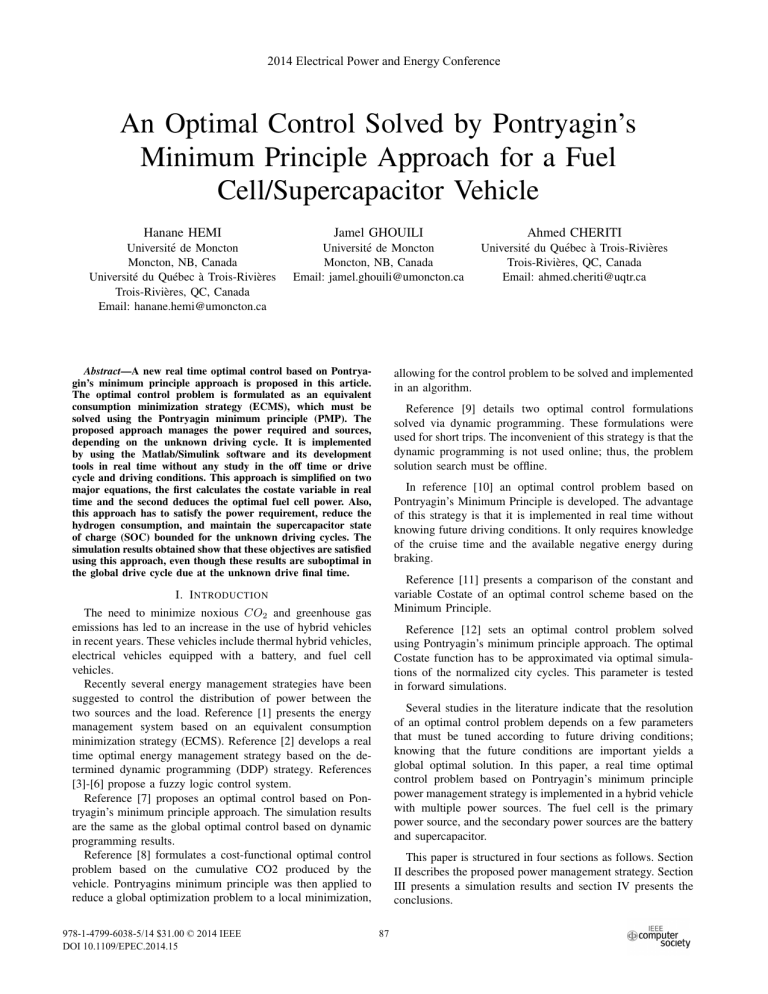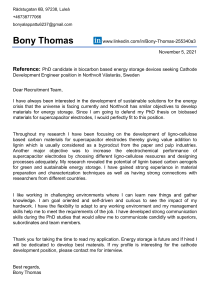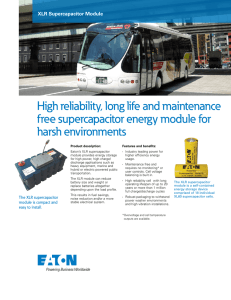
2014 Electrical Power and Energy Conference An Optimal Control Solved by Pontryagin’s Minimum Principle Approach for a Fuel Cell/Supercapacitor Vehicle Hanane HEMI Jamel GHOUILI Ahmed CHERITI Université de Moncton Moncton, NB, Canada Université du Québec à Trois-Rivières Trois-Rivières, QC, Canada Email: hanane.hemi@umoncton.ca Université de Moncton Moncton, NB, Canada Email: jamel.ghouili@umoncton.ca Université du Québec à Trois-Rivières Trois-Rivières, QC, Canada Email: ahmed.cheriti@uqtr.ca Abstract—A new real time optimal control based on Pontryagin’s minimum principle approach is proposed in this article. The optimal control problem is formulated as an equivalent consumption minimization strategy (ECMS), which must be solved using the Pontryagin minimum principle (PMP). The proposed approach manages the power required and sources, depending on the unknown driving cycle. It is implemented by using the Matlab/Simulink software and its development tools in real time without any study in the off time or drive cycle and driving conditions. This approach is simplified on two major equations, the first calculates the costate variable in real time and the second deduces the optimal fuel cell power. Also, this approach has to satisfy the power requirement, reduce the hydrogen consumption, and maintain the supercapacitor state of charge (SOC) bounded for the unknown driving cycles. The simulation results obtained show that these objectives are satisfied using this approach, even though these results are suboptimal in the global drive cycle due at the unknown drive final time. allowing for the control problem to be solved and implemented in an algorithm. Reference [9] details two optimal control formulations solved via dynamic programming. These formulations were used for short trips. The inconvenient of this strategy is that the dynamic programming is not used online; thus, the problem solution search must be offline. In reference [10] an optimal control problem based on Pontryagin’s Minimum Principle is developed. The advantage of this strategy is that it is implemented in real time without knowing future driving conditions. It only requires knowledge of the cruise time and the available negative energy during braking. Reference [11] presents a comparison of the constant and variable Costate of an optimal control scheme based on the Minimum Principle. I. I NTRODUCTION The need to minimize noxious CO2 and greenhouse gas emissions has led to an increase in the use of hybrid vehicles in recent years. These vehicles include thermal hybrid vehicles, electrical vehicles equipped with a battery, and fuel cell vehicles. Recently several energy management strategies have been suggested to control the distribution of power between the two sources and the load. Reference [1] presents the energy management system based on an equivalent consumption minimization strategy (ECMS). Reference [2] develops a real time optimal energy management strategy based on the determined dynamic programming (DDP) strategy. References [3]-[6] propose a fuzzy logic control system. Reference [7] proposes an optimal control based on Pontryagin’s minimum principle approach. The simulation results are the same as the global optimal control based on dynamic programming results. Reference [8] formulates a cost-functional optimal control problem based on the cumulative CO2 produced by the vehicle. Pontryagins minimum principle was then applied to reduce a global optimization problem to a local minimization, 978-1-4799-6038-5/14 $31.00 © 2014 IEEE DOI 10.1109/EPEC.2014.15 Reference [12] sets an optimal control problem solved using Pontryagin’s minimum principle approach. The optimal Costate function has to be approximated via optimal simulations of the normalized city cycles. This parameter is tested in forward simulations. Several studies in the literature indicate that the resolution of an optimal control problem depends on a few parameters that must be tuned according to future driving conditions; knowing that the future conditions are important yields a global optimal solution. In this paper, a real time optimal control problem based on Pontryagin’s minimum principle power management strategy is implemented in a hybrid vehicle with multiple power sources. The fuel cell is the primary power source, and the secondary power sources are the battery and supercapacitor. This paper is structured in four sections as follows. Section II describes the proposed power management strategy. Section III presents a simulation results and section IV presents the conclusions. 87 II. F ORMULATION OF O PTIMAL C ONTROL PROBLEM The Hamiltonian of the problem can be defined as equation (10) [9], [7], [10]: The optimal control problem is formulated as equivalent fuel consumption. Also, this approach has to protect the supercapacitor from overcharging during the repetitive braking energy accumulation. The equivalent fuel consumption is composed by two equation. The first converts supercapacitor power consumption to an equivalent amount of fuel, and the second presents the hydrogen consumption by fuel cell. The objective function J is given in equation (1) [1], [11]. Minimizing the objective function lead up to find the optimal power split between the fuel cell and supercapacitors. The control action u(t) = Pf c is considered as fuel cell power. The supercapacitor power is given in equation (2). The equation (3) is a weighting factor to achieve supercapacitor state of charge (SOC) regulation. The equation (4) gives the relation between the supercapacitor state of charge and the state of energy (SOE). tf (ṁf (Pf c (t)) + s(t)P sc(t)) dt (1) J= ˙ H = ṁf (Pf c (t)) + s(t)P sc(t) + λ(t)SOE(t) where λ(t) is the Costate function. The state and the adjoint equations are defined as equations (11) and (12) [7], [10]. ∂H(t, SOE(t), Pf c (t), λ(t)) ˙ SOE(t) = ∂λ (2) SOE(t) = SOC 2 (t) (4) ∂H(t, SOE(t), Pf c (t), λ(t)) (12) ∂SOE According to Pontryagin’s minimum principle, the optimal control variable, Pf∗c , is obtained using equation (13). ∂H(t, SOE(t), Pf c (t), λ(t)) =0 ∂Pf c Vsc(t) Vsc.max Isc (t) = C V̇sc (t) (3) III. S IMULATION RESULTS AND DISCUSSION The MATLAB/Simulink suite and SimPowerSystems and SimDriveline library are used to model the electrical and mechanical elements of hybrid vehicles. The fuel cell is a 400 cell, 288 Vdc , 100 kW Proton Exchange Membrane Fuel Cell(PEMFC). The fuel cell parameters are shown in Tab.II. The supercapacitor is a 288 V , 27.78 F , and the supercapacitor used is a BMOD0500 P016. The electric motor is a 288 Vdc , 100 kW permanent magnet synchronous machine (PMSM). The mechanical model of the vehicle is modeled by using the SimDriveline library [15]. The vehicle parameters are given in table Tab.I. They are obtained from Honda Clarity vehicles [16]. (5) (6) where ṁf is instantaneous fuel cell consumption (kg/s), Pr and Pf c and Puc are required, fuel cell and supercapacitor power (W ), LHVH2 is low heat value of hydrogen (M j/kg). The dynamic system is presented in equation (7). ˙ SOE(t) = 2Psc 2 CVsc.max TABLE I: Vehicle parameters (7) 2 where C is the supercapacitor capacity (F ) and Vsc.max is the supercapacitor maximum voltage (V ). Equation (7) is determined using equation (5) and (6) ˙ SOE(t) ˙ 2 (t) = SOC ˙ = 2SOC(t)SOC(t) Vsc V̇sc = 2 Vsc.max Vsc.max Vuc Isc = 2 Vsc.max C.Vsc.max 2Psc = CV 2 Dimensions weight Occupancy Overall length (inches) Overall width (inches) Overall height (inches) Tread (front/rear,inches) Wheelbase (inches) Vehicle weight (kg) Number of occupants Maximum speed (mph) 190,3 72,7 57,8 62,2/62,8 110,2 1625 4 100 (8) TABLE II: Fuel cell parameters Open circuit voltage Nominal stack efficiency Operating temperature Nominal Air flow rate Nominal fuel supply pressure Nominal air supply pressure Nominal composition H2 (air) Nominal composition O2 /H2 O(air) sc.max Equation (9) presents the system local constraints. ⎧ ⎪ ⎨Pf c.min ≤ Pf c ≤ Pf c.max Psc.min ≤ Psc ≤ Psc.max ⎪ ⎩ SOCsc.min ≤ SOCsc ≤ SOCsc.max (13) The resolution of the necessary conditions of equations (11), (12) and (13) leads to the optimal solution of Pontryagin’s minimum principle. The boundary condition must be satisfied (equation (14)) [18]. In this paper, the future conditions of the driving cycle are unknown; in fact, the final time, tf , is unknown. SOE(ti ) = SOE(tf ) (14) The supercapacitor state of charge is defined by equation (5), and the supercapacitor current Isc is obtained by equation (6). SOC(t) = (11) λ̇(t) = − t0 P r(t) = Pf c (t) + Psc (t) SOE(t) − 1 s(t) = LHVH2 SOCmin SOCmax (10) (9) 88 V % 0C lpm bar bar % % 400 57 95 1698 3 3 99.95 21/1 Fig. 1: Fuel cell/Supercapacitor vehicle configuration Fig. 1 shows Fuel cell/Supercapacitor vehicle configuration. The power management strategy is detailed with green color. The power required during a drive is calculated depending the pedal position. The fuel cell power is determined in the optimal control block. The required fuel cell current is given by a lookup table and compared the fuel cell measured current to control the chopper by a PI controller. The reference current is also used by the fuel cell system to feed the stack with Hydrogen and Oxygen. In the case of supercapacitor, a PI controller generates PWM signals from the differences between the reference DC bus voltage, which maintained at 288 V and the DC bus measured voltage to control the bidirectional buck/boost chopper. A braking chopper is added to protect the supercapacitor from a supplement of energy during a regenerative braking. In this simulation, the optimal control problem is solved using Pontryagin’s minimum principle for the UDDS drive cycle. This drive cycle was selected to analyze the performance of the proposed power management strategies. Because this cycle contains more accelerations and decelerations than other drive cycles, the hybrid vehicle loses more energy and the efficiency of the system decreases. The simulation includes two parts to analyse the proposed approach for different driving conditions. First, the drive cycle is used, and the vehicle mass is 1625 kg. Second, the drive cycle is multiplied by two Vref = 2×VU DDS , and the vehicle mass is 2500 kg. The measured car speed in these two parts is presented in Fig. 2 (a) and (b). The optimal control block shown in figure 1 calculates optimal fuel cell power during a drive cycle, and the supercapacitor power is deduced by the difference between the required power and fuel cell power. Fig. 3 (a) and (b) illustrate the power obtained from the two sources. The required power (motor power) at the DC bus is allocated between the fuel cell power and supercapacitor power. In the two speeds references, the optimal fuel cell and supercapacitor power respect the constrains imposed in the optimal control problem. 89 66 60 car speed car speed reference 64 50 62 state of charge (%) speed (km/h) 40 30 20 60 58 56 54 10 52 0 0 200 400 600 800 1000 1200 50 0 1400 time (s) 200 400 600 800 1000 1200 1400 800 1000 1200 1400 time (s) (a) (a) 120 100 car speed car speed reference 100 90 state of charge (%) speed (km/h) 80 60 40 20 0 0 200 400 600 800 1000 1200 80 70 60 50 1400 time (s) (b) 40 0 200 400 600 time (s) Fig. 2: Car speed with (a) mv = 1625 kg and Vref = VU DDS (b) mv = 2500 kg and Vref = 2 × VU DDS (b) Fig. 4: Supercapacitor state of charge with (a) mv = 1625 kg and Vref = VU DDS (b) mv = 2500 kg and Vref = 2×VU DDS 4 1.5 x 10 Motor power Fuel cell power Supercapacitor power 1 0.2 0 Power (w) 0.5 −0.2 −0.4 0 () −0.6 −0.5 −0.8 −1 −1 0 200 400 600 800 1000 1200 −1.2 1400 time (s) −1.4 (a) −1.6 0 200 400 600 800 1000 1200 1400 800 1000 1200 1400 time (s) 4 8 x 10 Motor power Fuel cell power Supercapacitor power 6 (a) 1 4 −1 0 () Power (w) 0 2 −2 −3 −4 −6 0 −2 −4 200 400 600 800 1000 1200 1400 time (s) −5 0 (b) 200 400 600 time (s) (b) Fig. 3: Motor, fuel cell, and supercapacitor power with (a) mv = 1625 kg and Vref = VU DDS (b) mv = 2500 kg and Vref = 2 × VU DDS Fig. 5: Costate variable with with (a) mv = 1625 kg and Vref = VU DDS (b) mv = 2500 kg and Vref = 2 × VU DDS 90 To calculate this optimal fuel cell power, the knowledge of the supercapacitor state of energy is required during a drive cycle. This state of energy represents the optimal control block input. This state of energy SOE(t) = SOC 2 (t) must be maintained bounded to improve the supercapacitor life cycle and protect it from surcharge. For the two different driving conditions of the simulation, the optimal SOE(t) = SOC 2 (t) trajectories are shown in Fig. 4 (a) and (b). Those figures show that the the difference between the supercapacitor initial time and final time is less then 10%, knowing that this study is based on unknown drive cycle and any informations about the drive final time. The optimal control Costate function is presented in Fig. 5 (a) and (b) and calculated from two equations (11) and (12). The supercapacitor state of energy for the different driving conditions is important to calculate the costate variable. As 450 400 voltage (V) 300 250 200 150 100 0 200 400 800 1000 1200 1400 (a) 450 400 voltage (V) 350 Motor current Fuel cell current Supercapacitor current 40 Motor voltage Fuel cell voltage Supercapacitor voltage 300 250 200 20 150 0 100 0 200 400 600 800 1000 1200 1400 time (s) −20 (b) Fig. 7: Motor, fuel cell, and supercapacitor voltage with (a) mv = 1625 kg and Vref = VU DDS (b) mv = 2500 kg and Vref = 2 × VU DDS −40 −60 0 600 time (s) 60 current (A) Motor voltage Fuel cell voltage Supercapacitor voltage 350 200 400 600 800 1000 1200 1400 time (s) (a) Fig. 6 (a) and (b) present the current of these sources and the required current (motor current) at the DC bus. Fig. 7 (a) and (b) illustrate the fuel cell and supercapacitor voltages. The bus voltage is maintained at 288 Vdc . Tab.III gives the fuel cell consumption depending on the vehicle conditions. The mass and speed are variable. 300 Motor current Fuel cell current Supercapacitor current 250 200 current (A) 150 100 50 0 −50 TABLE III: Hydrogen consumption −100 −150 −200 0 Conditions 200 400 600 800 1000 1200 1400 Distance (km) Duration (s) Consumption (l) time (s) (b) Fig. 6: Motor, fuel cell, and supercapacitor current with (a) mv = 1625 kg and Vref = VU DDS (b) mv = 2500 kg and Vref = 2 × VU DDS VU DDS mv = 1625 kg 7,29 1400 76,49 2 × VU DDS mv = 2500 kg 14,568 1400 493,32 IV. C ONCLUSION This paper presents an optimal control using Pontryagin’s minimum principle approach for fuel cell/supercapacitor electrical vehicle. The simulation results show that the power requirement for the unknown driving cycles, and the power distribution among various power source are satisfying. Also the results indicate that the hydrogen consumption is lower during a drive cycle, and the supercapacitor state of charge is bounded at the interval desired. In addition, this approach is easy to implement and hasn’t required any system expertise compared with other strategies like Fuzzy logic method. This approach is easy to be implemented in real time because it is based on the shown in figures, this variable is not constant, it is calculated in real time and not deduced from any off time study. This method gives an independence of the system of knowledge of future driving conditions to calculate this costate variable. Equations (11 and 13) calculate the optimal fuel cell power and a lookup table is used to deduce a fuel cell current. The supercapacitor current is the deference between required current and fuel cell, adding to that, the regenerative braking current is absorbed by supercapacitor, so the braking chopper absorbs the extra current that is not authorized by contractor. 91 instantaneous minimization of the Hamiltonian. Furthermore, the future conditions of the driving cycle are unknown, the final time, tf , is unknown. The Costate variable is calculated in real time using equation (12) and it is not constant. This approach is suboptimal due to the aforementioned reasons. By adding an algorithm that predicts the future driving conditions, this approach can yield the optimal solution. R EFERENCES [1] P. Garcia, J.P. Torreglosa, L.M. Fernndez and all, Viability study of a FCbattery-SC tramway controlled by equivalent consumption minimization strategy, International Journal of Hydrogen Energy, 2012, 37:9368-9382. [2] L. Xu, F. Yang, J. Li and all, Real time optimal energy management strategy targeting at minimizing daily operation cost for a plug-in fuel cell city bus, International Journal of Hydrogen Energy, 2012. .37: 1538015392. [3] Q. Li, W. Chen, Y. Li and all, Energy management strategy for fuel cell/battery/ultracapacitor hybrid vehicle based on fuzzy logic, International Journal of Electrical Power and Energy Systems, 2012, 43:514525. [4] H. Hemi, J. Ghouili, A. Cheriti, A real time fuzzy logic power management strategy for a fuel cell vehicle. Energy Conversion and Management, 2014, 80, 63-70. [5] C-Y. Li, G-P. Liu, Optimal fuzzy power control and management of fuel cell/battery hybrid vehicles, Journal of Power Sources, 2009, 192:525533. [6] O. Erdinc, B. Vural and M. Uzunoglu, A wavelet-fuzzy logic based energy management strategy for a fuel cell/battery/ultra-capacitor hybrid vehicular power system, Journal of Power Sources, 2009, 194:369-380. [7] N. Kim; S. Cha; H. Peng, Optimal Control of Hybrid Electric Vehicles Based on Pontryagin’s Minimum Principle, Control Systems Technology, IEEE Transactions on , vol.19, no.5, pp.1279,1287, Sept. 2011 [8] S. Stockar; V. Marano; M. Canova; G. Rizzoni; L. Guzzella, EnergyOptimal Control of Plug-in Hybrid Electric Vehicles for Real-World Driving Cycles, Vehicular Technology, IEEE Transactions on , vol.60, no.7, pp.2949,2962, Sept. 2011 [9] W. Dib, L. Serrao, A. Sciarretta, Optimal control to minimize trip time and energy consumption in electric vehicles, Vehicle Power and Propulsion Conference (VPPC), 2011 IEEE, vol., no., pp.1,8, 6-9 Sept. 2011 [10] R. Razavian, N.L. Azad, J. McPhee, On real-time optimal control of a series Hybrid Electric Vehicle with an ultra-capacitor, American Control Conference (ACC), 2012 , vol., no., pp.547,552, 27-29 June 2012 [11] C.H. Zheng, N.W. Kim, S.W. Cha, Optimal control in the power management of fuel cell hybrid vehicles, International Journal of Hydrogen Energy, Volume 37, Issue 1, January 2012, Pages 655-663, ISSN 03603199 [12] N. Kim; S.W. Cha; H. Peng, Optimal Equivalent Fuel Consumption for Hybrid Electric Vehicles, Control Systems Technology, IEEE Transactions on , vol.20, no.3, pp.817,825, May 2012 [13] Maxwell Technologies Products, http://www.maxwell.com/. [14] H. Hemi, J. Ghouili, A. Cheriti, A real time energy management for electrical vehicle using combination of rule-based and ECMS. In Electrical Power and Energy Conference (EPEC), 2013 IEEE (pp. 1-6). IEEE. [15] MathWorks, http://www.mathworks.com. [16] Honda, Fuel Cell Power FCX, http://automobiles.honda.com/fcxclarity/specifications.aspx. [17] O. Tremblay, L-A. Dessaint, Experimental validation of battery dynamic model for EV applications, World electric vehicle journal,2009, Vol. 3 - ISSN 2032-6653. [18] B. Sampathnarayanan; S. Onori; S. Yurkovich, An optimal regulation strategy for energy management of hybrid electric vehicles, Decision and Control (CDC), 2012 IEEE 51st Annual Conference on , vol., no., pp.7063,7068, 10-13 Dec. 2012 92



